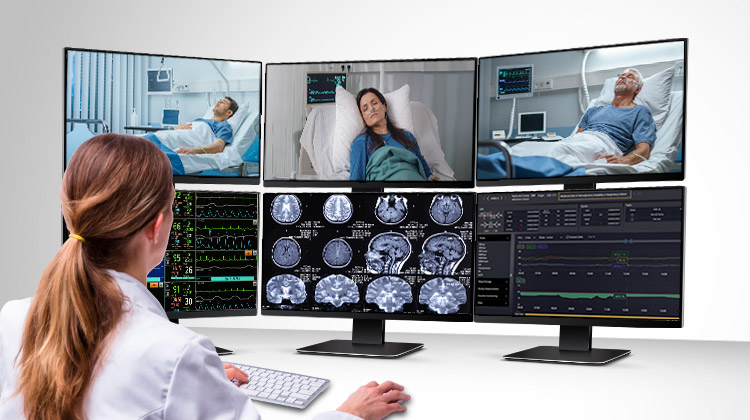The image of an ICU nurse vigilantly monitoring patients has long been the cornerstone of intensive care. However, the healthcare landscape is changing rapidly, and with it, the very boundaries of where critical care is delivered.
In this article, discover how tele-ICU improves patient outcomes, expands care access, and offers work-life balance for nurses. Learn about challenges, best practices, and the technology shaping the future of intensive care.
Telemedicine in the ICU: Enhancing Intensive Care Delivery

Fundamentally, there are three main uses for Telemedicine: (1) extending coverage (e.g. Critical Access Hospitals (CAH) providing care to patients who would otherwise have limited access to specialists); (2) improving compliance (monitoring patients' adherence to treatment plans); and (3) facilitating transfers (when specialists consult with one another on transferring a patient to another facility).
Tele-ICU nurses leverage real-time video and audio feeds from strategically placed cameras to remotely review medical records, analyze data, interpret vital signs, tackle complex patient situations with colleagues, and perform routine and unscheduled patient surveillance.
For telehealth practitioners, telesitting (RPM) offers a unique path to career development and specialization. Moreover, tele-intensive care provides greater flexibility and work-life balance than traditional settings, which appeals to nurses who want a different work dynamic. Meanwhile, offsite help can reduce stress for bedside nurses by providing additional support and expertise to ease workloads.
Challenges and Best Practices in Tele-Intensive Care
While tele-intensive care offers numerous benefits for an organization, it also presents unique challenges:
- Physical limitations: Nurses who are used to working in a traditional bedside setting may find it difficult to adjust to the virtual environment. They may be frustrated by the inability to physically assess and intervene with patients. Additionally, virtual and bedside teams can mix up information during shift changes, especially when nurses are busy.
- Building trust: Gaining acceptance and collaboration from bedside nurses can be challenging initially. Communication and language barriers can be more complex in a virtual setting, with a greater need for clear and concise instructions and accurate interpretation. Poor video and audio equipment can magnify these pain points, for example, due to latency caused by slow Internet speed or the inability to see true-color images and video.
- Isolation: Working in a remote environment and long hours of screen time can lead to feelings of isolation.
To address these challenges, leadership support is needed to successfully integrate the virtual and on-site teams. Drawing from case studies, some proven strategies include:
- Shared governance: Fostering collaboration through outreach programs and shared decision-making so tele-ICU nurses are not forgotten and thought of as just faces on computer screens.
- Healthy workplace initiatives: Providing resources for stress and ergonomics management (workstation setups alleviating back, shoulder, neck, and vision strains from prolonged computer use).
- Continued education: Ensuring tele-ICU nurses stay up-to-date on bedside workflows and technological advancements.
Leadership buy-in and understanding the challenges are a great start, as are technological considerations that enable tele-ICU nurses to reach their full potential.
Advanced Equipment Empowering Tele-ICU Nurses

The integration of technologies like AVer’s PTZ cameras in tele-ICU settings, as seen in a private hospital in New Taipei City, highlights the broader trend of how advanced equipment is transforming ICU nursing. PTZ cameras, like AVer's medical-grade certified IEC 60601-1-2, offer two-way communications and minimize the need for nurses to move frequently between stations. By streamlining workflow, nurses can spend more time directly helping patients, potentially leading to lower mortality rates and shorter hospital stays thanks to timely interventions.
Beyond audio-visual advancements, other technological innovations are also making significant contributions. For instance, wearable patient monitoring devices and automated medication dispensers reduce manual tasks and minimize medication errors; smart beds gather real-time patient movement data and vital signs; and remote telemetry enables continuous cardiac monitoring. Integrating these devices with electronic health records (EHR) software is key to smoother care coordination and reducing miscommunications during shift handovers.
Collectively, these technologies not only streamline operations but also allow nurses to focus on intensive care tasks, enhancing patient outcomes through earlier intervention and more informed decision-making.
Shaping the Future of Tele-ICU: Healthcare Policies and Global Initiatives
As the global focus on patient care intensifies, so does the pace of advancements in healthcare, telehealth technologies, and an emphasis on healthcare reforms. Across Europe, substantial investments in healthcare infrastructure, exemplified by initiatives like the UK's NHS Long Term Plan, Italy’s national health system upgrade, and Germany's Hospital Future Act (KHZG), signal a movement toward integrating advanced healthcare technologies as well as digitalization and modernization of national healthcare system. The future of tele-ICU and healthcare in general is poised to be as transformative as it is inclusive, moving us closer to a reality where quality healthcare knows no boundaries.
Explore how AVer’s Connected Health Solutions offer a win-win for everyone involved and the future of the ICU.